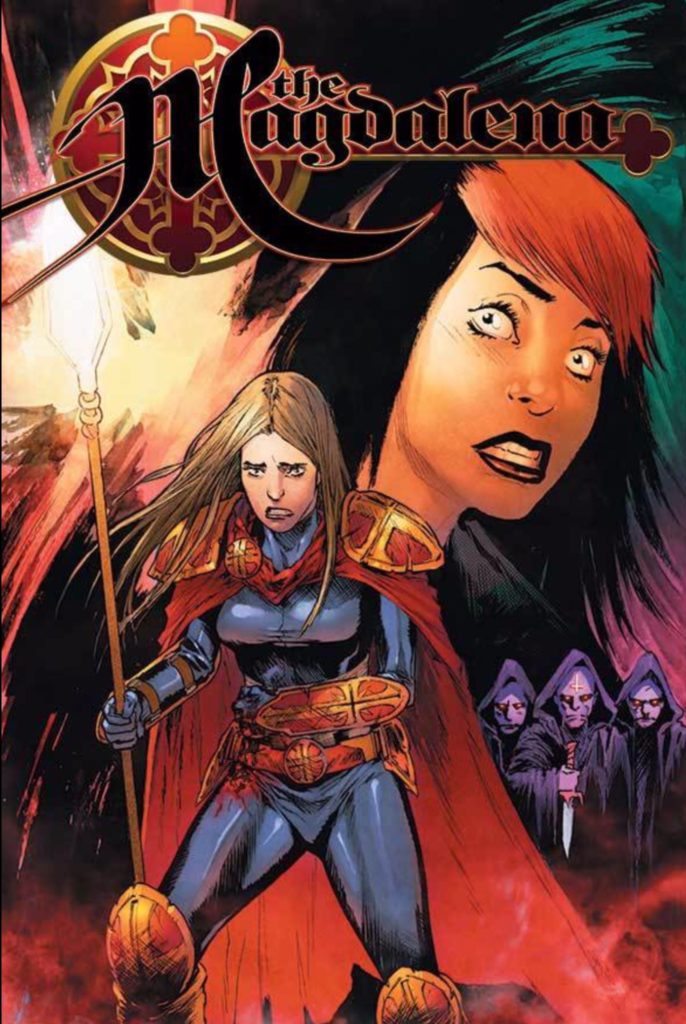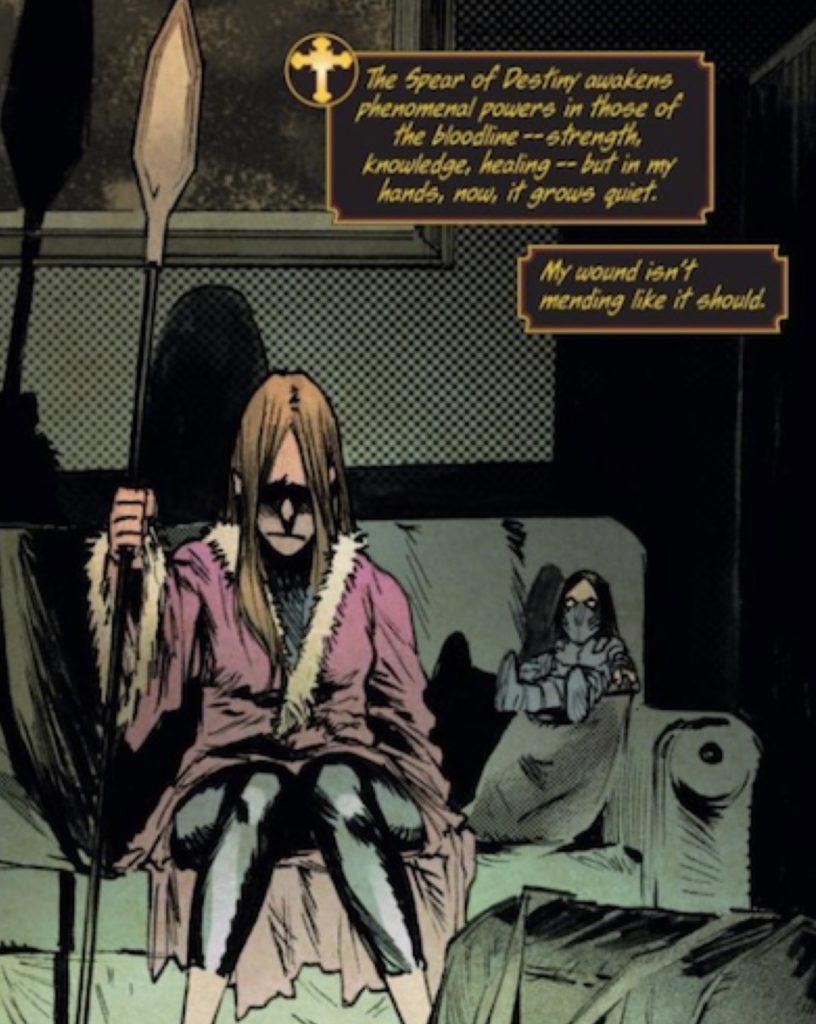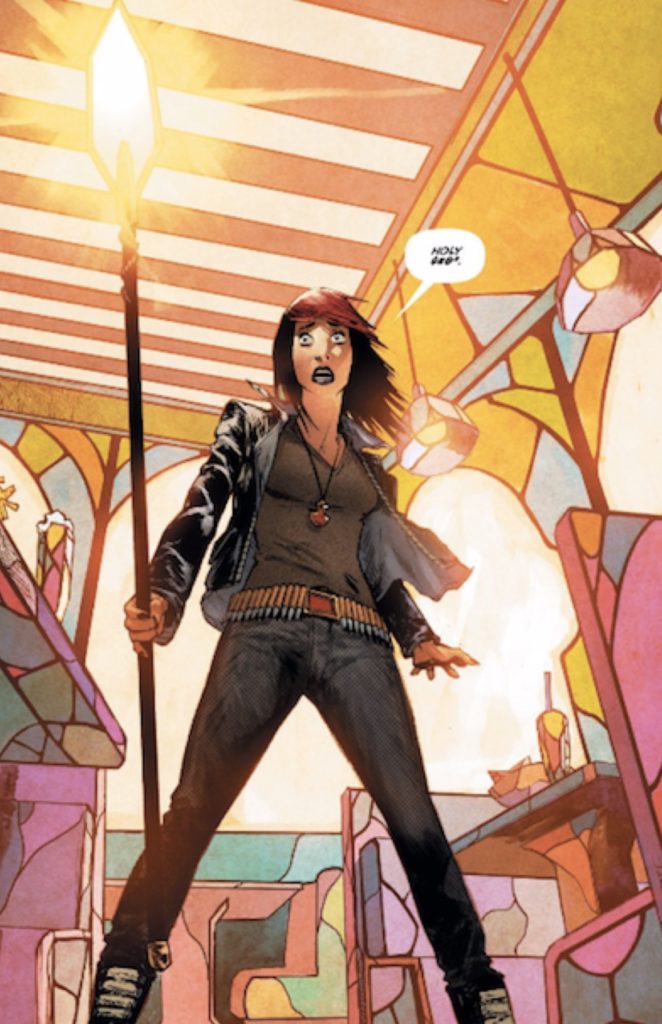It seems appropriate to begin here with a confession: Forgive me, readers, for I am skeptical. So, the Catholic church, an entity that has subjugated women like it’s their job for literally centuries, has, as their secret, a supernaturally powerful champion woman descended from Mary Magdalene and Jesus? Haha, good one! Maybe lay off the communion wine?
Looking back at the character over the years (her first appearance was in The Darkness #15 in 1998), The Magdalena’s battle bikini wardrobe would preclude her from even entering any number of Catholic churches around the world. What I’m saying is, before I even started reading, I had serious doubts about the very premise of The Magdalena. How would this creative team convincingly turn such cognitive dissonance into a compelling conflict?
Catholicism has certainly faced its share of critique over its own cognitive dissonances. (See the Protestant Reformation, for one.) In her writer notes, Tini Howard calls out the Reformation as a philosophical underpinning for her take on Patience, the Magdalena who begins this story. “In a way, think of this volume of The Magdalena like our Reformation, nailed to the door, preaching our truth. Patience defied the Vatican, but she never stopped believing.” It’s a good place to start. In the previous series, Patience was all about reclaiming agency in her role as the Magdalena and, by extension, her relationship to her faith, and to her destiny.
After a difficult battle with a particularly nasty demon in the opening scene of this issue, Patience is seriously wounded, and her inability to heal as she usually can leaves her questioning her destiny. Does God want her to retire? Whether or not the Church acts as an intercessor, her powers are still bequeathed from the divine. But since this relationship is just between Patience and her creator, she can’t brush off her doubts as dissatisfaction with the Church. This crisis of faith is about a crisis of faith in herself.
Co-writers Tini Howard and Ryan Cady use Patience’s existential plight as the launching point for their story. These doubts Patience feels ultimately empower her to take on the next phase of her destiny, as mentor rather than Magdalena. It’s an elegant solution to the patriarchy that Catholicism casts over the character. Neither God nor man is putting Patience out to pasture. No one is trading her in for someone younger and hotter. She is still a protagonist in her own story, on the verge of its next chapter.
If you’ll indulge me (yes, Catholic pun intended) a little subtextual nudging, this is about a woman realizing that she has more to offer than her spilled blood. Patience’s body is no longer useful in the way it once was, but that doesn’t mean that she, herself, is useless. Destiny isn’t a fixed point. It can evolve along with us as long as our faith in it is cultivated from within. For Patience to find in her doubts the motivation to evolve her own destiny, rather than discard it in some sort of loss of faith, is a feminist act within such an oppressive framework as Catholicism. All the symbols and ritual and honorifics in the world don’t define Patience, her faith, or her destiny. Only she can do that for herself.
Enter LA goth-girl Maya. Between chafing under the expectations of her devoutly Catholic mother and choking on the vague miasma of her own ennui, Maya is looking for her destiny, and just about anything will do as long as it’s intense. Something as steeped in pageantry and drama as goth tends be, at least that’s something to break up the monotony Maya fears is her fate. From a certain perspective, goth culture has a lot in common with the Catholic church; it doesn’t necessarily provide any direct or substantive relief to one’s existential angst, but damned if it isn’t a good show.
Maya gets a lot more than she bargained for when a boy she likes turns out to be dealing with demons. I’m not sure it gets any more goth than that. (My most goth ex-boyfriend was just in a band with the word “devil” in its name.) In the chaos of the demon’s appearance, the Spear of Destiny, used to stab Christ on the cross and hereditary weapon of the Magdalena, calls to Maya. And so Patience, who begins this issue doubting herself, understands how important she still is. Because who better to train the new Magdalena than the one person who knows best what it’s like to be her? And Maya, who wished she was something more than she was, is about to become more than she ever imagined.
Artist Christian DiBari is clearly having a great time drawing demons. The demon Marchosias is probably what you’d get if a spider and a pachycephalosaurus had a baby who grew up to never skimp at bench presses. Colorist Mike Spicer eschews the expected dark demonic hues, but Marchosias is no less menacing for his lively colors. I appreciate that kind of creativity and I want to see more demonic creatures from this duo.
DiBari and Spicer do an excellent job with visual cues that something demonic, spiritual, or supernatural is at play. Look for the subtle palette changes, unnervingly wild-eyed faces, hints of gore, and, oh yes, a massive swarm of flies. I was especially impressed by the coloring and stained-glass effect on the page when Maya grabs the spear (and the line of dialogue she says is absolutely perfect). It was a nice nod to Catholic art without being too heavy-handed about it.
A nice nod without being too heavy-handed about it is probably the best way to sum up this new Magdalena book. They deal with the problems inherent in the premise by subverting them into in-universe conflicts. Between a legacy character who has been around in comics for a while, and the entire mythology of Catholicism and demonology, not to mention maybe appealing to new readers like me, the creative team has a lot to juggle. Instead of doing 10 Hail Marys in penance for not believing in this book, maybe I’ll just make sure to pick up the next issue.





